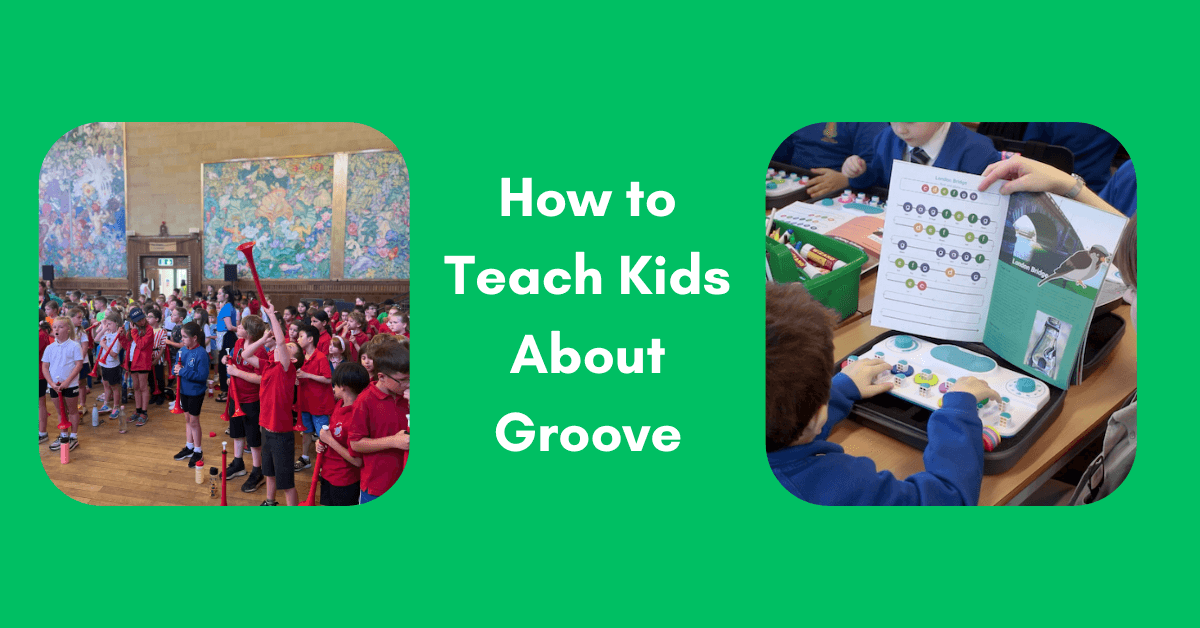
Following our blog about rethinking music lessons on timbre, Lewis Clarke from Soundbops is here again to give teachers new ways to approach music lessons. Even if you are a teacher who has never picked up an instrument in your life, we’ll be discussing ideas that everyone can get involved with.
This article focuses on teaching kids about groove.
Get in the groove!
You’re probably familiar with the idea of music having a groove, but it’s often unclear what exactly is being referred to when music has or, tragically, hasn’t got this elusive quality.
Is it to do with how danceable a track is?
How good ‘the vibe’ is?
Something to do with Austin Powers?
The answer is yes to all, but primarily it's to do with pulse and rhythm.
The pulse (or beat) is the consistent speed kept by a metronome in a piece of music, and it is the measure people use to gauge if something is ‘in time.’ If no metronome is playing, you can still usually hear where the strong beats are if you try to dance or tap along.
The rhythm, then, goes on top of the pulse and can be a little more flexible. Since you’re already tapping along, try repeating words out loud with each pulse. Animal names - Pig, Tiger, Butterfly, Kingfisher, Caterpillar (and combinations of any and all) - are what I often use to demonstrate rhythm, because the stresses and syllables are quite different for each.
‘Pig’ takes up a whole beat to itself, whereas most of the syllables in ‘Caterpillar’ fill out the space in between. Play around with these and you’re already building your own simple rhythms!

[Green markers denote where the rhythm is landing on the pulse; blue, where it is not on the pulse, often called an offbeat]
Going down swingin’
With that out of the way, we are getting closer to finding out what groove is all about. But to understand groove we must first understand swing, and to understand swing we need to talk about jazz.
When we introduce rhythm to the classroom, there is a tendency to only talk about the ones which we find in classical music. Classical music does not groove. Actually, the entire way that classical music is written (and this applies to anything written with traditional music notation) is extremely limited in expressing a sense of groove.
The divisions used in notation - whole notes, quarter notes, eighth notes, sixteenth notes, etc. - imply that the space we leave between notes should always be equal, and usually split into divisions of four.
This method would be fine if we were dividing a cake and everyone wanted an even slice. But music is an ongoing experiment with sound, and it turns out that imbalance - when done right - sounds great! Uniformity is certainly useful for many genres that want to achieve a rigid or mechanical sound, but it isn’t indicative of all (and arguably most) music!
This leads us neatly to swing!
Swing is an unevenly divided rhythm that still lands on the beat, characteristic of jazz music. Where the ‘-Ger’ of our Tiger would usually fall exactly halfway between pulses, when we’re swinging it would come in just after halfway.

How does this look in traditional notation (above, left) compared to another more modern visual representation (above, right) of where the notes actually fall? Even if you can read sheet music, the left image only approximates a swung rhythm. It is far too rigid. We can see in the right image that the beats don’t align with the evenly quartered grid.
Listen to some jazz to hear an example (or Jingle Bell Rock if you’re a philistine who just wants a familiar model and doesn't care if it's jarringly out of season) and you’ll hear that there is a distinct bounce to these swung rhythms. Experiment by seeing how late you can leave the ‘-Ger’ and still land on the new beat.
Swing, and how much something is swung, is a spectrum: the later you leave it the more abrupt the bouncy feeling will become and the harder you’re swinging.
Groove is in the heart
And finally, we can come back to groove. Although swinging can be tricky at first, you’ll hopefully have found a manageable speed to feel a consistent bounce in the rhythm. That experience of locking in with the rhythm - keeping time and anticipating each bounce - is groove!
And, if you were struggling to get this on your own, don’t worry because it’s actually something that’s easier in group dynamics (perfect for a classroom). If the whole room is really immersed in the music, and everyone is dancing along to the beat, they are subconsciously grooving with the music. Once you’re in it, it should begin to feel effortless and driving, like walking down a hill.

Obviously, the pressure is on the musicians who are leading the groove to maintain that collective energy, but at the heart of it is teamwork. The ultimate group work exercise is grooving together: synchronisation without uniformity.
When teaching music with traditional methods, we can get so caught up with reading from a page and trying to play exactly what’s written, that we lose sight of the communal aspects that should be at the heart of music making.
I hope that giving groove the spotlight has, firstly, helped you think about rhythm a little differently, and secondly, has helped give you some ideas on how to redirect the focus away from written music and back toward having fun making sounds together. The truth is that people won’t always notice when the music is right or wrong, but they definitely will notice when it grooves.
Topics:
